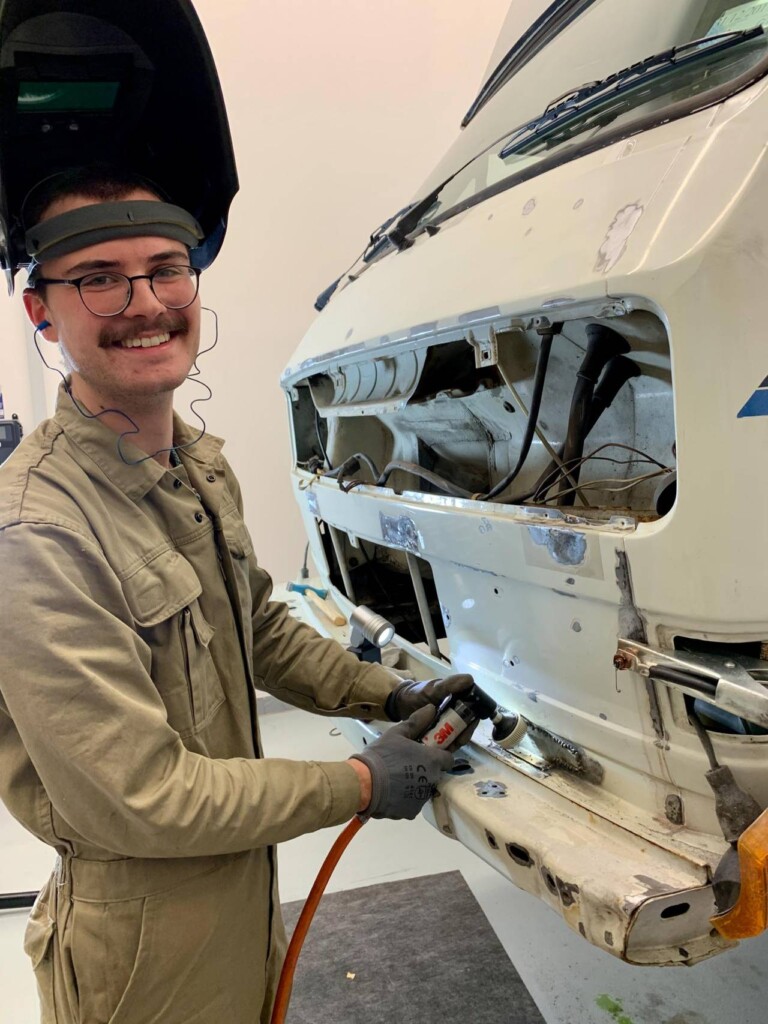VW Bus servicing may not be the first thing that comes to mind when you purchase your vehicle but it should be! Experiencing mechanical problems on the road will quickly turn your Buslife dream into a nightmare. In this article, we’ll give you the low-down on everything you need to know about servicing your VW Bus and how often you need to do it. Can’t I take it to the garage, you ask? Absolutely, but trust us, understanding the ins and outs of your vehicle will fill you with newfound confidence when it comes to VW Bus maintenance.
Whether you’ve recently purchased a VW Bus, or owned one for a while, we hope you find this article useful. We also have plenty of other helpful guides to get you started when it comes to restoration and maintenance. Check them out under our Renovation category.



What is a vehicle service?
Think of a service as a regular health check for your VW Bus. Regularly, you or your mechanic will run through necessary items on your service checklist and carry out some routine maintenance.
Are vehicle services a legal requirement?
It is recommended to check a variety of elements, including your vehicle’s fluid levels and tires, to ensure they are not only safe but running efficiently.
Buslifer top tip: In some countries, as well as a recommended service, you might be legally required to get your VW Bus inspected annually to ensure it’s roadworthy. For example, vehicles registered in the UK need an annual MOT certificate but, in the US, only some states require your vehicle to pass an annual safety inspection and emissions test. Learn more about vehicle inspection requirements in the country you are traveling in here.
Why do I need to service my VW Bus?
To put it simply, servicing your VW Bus ensures your vehicle is safe. There are several reasons why you really should be getting your vehicle serviced regularly.
- You’re less likely to break down. A service aims to highlight any underlying problems with your vehicle before your grind to a halt.
- For insurance purposes. If you have a good service history, this could improve the valuation of your VW Bus if you need to claim on your insurance. In some cases, your provider may use your service history to estimate its pre-accident value.
- It could save you money. Regular servicing of your vehicle could identify any issues that need fixing before your MOT is due and before you rack up some serious costs.
- You’ll be driving an efficient VW Bus. That’s right, the more often you service your vehicle, the smoother it will run and the better fuel consumption you’ll see on your Buslifer road trips.
- Your VW Bus will be more environmentally friendly. This is a complex subject to discuss when it comes to any vehicle, but the more you stay up to date with your servicing, the less impact you will have on the planet.
- You’ll improve your vehicle’s resale value. What is one of the top things to look for when buying a VW Bus? That’s right; it’s service history! You could increase the value of your vehicle considerably when you keep its service history up to date.
- Your vehicle will live longer. Nobody wants to have to say goodbye to their VW Bus due to age or mechanical problems, which is why yours could be around for much longer if you keep it well maintained.



Can I service my VW Bus myself?
Absolutely. Being a Buslifer is a wonderful life experience, but it’s not always easy on your wallet. This is why servicing your VW Bus yourself, could be the ideal money-saving option for you.
Buslifer top tip – servicing your vehicle yourself will require you to have a basic understanding of car mechanics. If you don’t already have a copy, we recommend getting yourself a Haynes manual for your VW Bus.
Tools you’ll need to service your VW Bus
Before you start trying to service your VW Bus yourself, stop and check you have all the correct tools to carry out the job quickly and safely.
You’ll need:
- Cloths and/or rags
- A funnel & bucket/tray
- Gloves
- Set of screwdrivers
- Wrench/spanner set
- Torque wrench
- Carjack
- Axle stands
- Socket set (with a spark plug socket)
- Oil filter pliers
- Tire pressure gauge and pump
You may also need to buy to following fluids to refill:
- Windscreen washer fluid
- Engine oil
- Coolant
- Brake fluid
- Transmission fluid
Buslifer top tip – refer to your vehicle manual for recommended fluid types.



VW Bus service checklist & DIY instructions*
*Dependent on the age and model of your VW Bus, your engine may be located at the rear of your vehicle or under the bonnet. For all part locations and recommended service times, check your vehicle manual or contact a mechanic.
1. Oil check
Essentially, oil keeps your engine running smoothly. To check its level, grab a rag and locate the dipstick (attached to the engine block). Pull out the dipstick and wipe the oil off with your rag. Re-insert, then pull out again and check if the oil level is between the two markers. If it’s towards the lower marker, you’ll need to top this up.
Top up your engine oil by removing the oil cap, inserting a funnel, and pour in your engine oil. Be careful not to overfill and recheck the level with your dipstick.
Check your engine oil every month.
To change your oil, place a bucket or container under the oil drainage plug located underneath the engine. Remove the oil cap, and using a socket wrench remove the drainage plug. Once empty, replace the plug and refill with engine oil.
Having replaced your engine oil, allow your vehicle to run for 10 minutes for the oil to circulate and ensure there are no leaks.
Change your engine oil every 4,000 – 7,000km.
2. Filters (Fuel, Air, Oil)
The filters in your vehicle help to catch any impurities and keep everything running efficiently. If you’re struggling to start your VW Bus or it’s struggling at low speeds, this could be a sign that you need to change your fuel filter. This is one of the more technical tasks you may need to carry out as part of a service, and you will need special tools for the job. Unless you are a confident mechanic, we would recommend taking your vehicle to a garage to change your fuel filter but for detailed instructions, have a read of this how-to guide.
Change your fuel filter every 30,000 – 160,000km.
To replace your air filter, locate your airbox (find its location in your vehicle manual) and unclip it to replace the dirty filter with a new one.
Change your air filter every 20,000 – 30,000km.
Your oil filter is located underneath the engine. To remove this, place a bucket underneath to catch excess engine oil and use your oil filter pliers to remove it. Screw on your new oil filter and run your engine for a few minutes to check there are no oil leaks.
Change your oil filter every 6,000km.
3. Check Tyres
Your tire’s condition and pressure are not only essential to check for safety reasons, but they will also help with the performance of your vehicle and its handling.
Consult the optimum tire pressure in your manual and check this with a tire pressure gauge and pump. Pump up your tires as needed.
When checking the condition of your tires, ensure the tread depth is 1.6mm.
Check your tire condition and pressure every couple of weeks.



4. Wash your VW Bus (underneath too!)
You may love or hate this job but washing your vehicle not only makes it look nice, but you will also be washing away any dirt or salt that could be causing metal damage.
Wash your vehicle every couple of weeks.
5. Touch up scratches
While washing your VW Bus, keep an eye out for scratches. These are better to deal with when they’re small and before they start causing significant paint damage. Use a scratch and repair product, such as turtle wax, for paint restoration.
Check for scratches every couple of weeks.
6. Check lights
You may not always spot a blown bulb straight away, so it’s a good idea to test your lights with each service.
If you need to change a headlight, you may need to lift your vehicle bonnet to remove the cover before disconnecting the bulb to replace it.
If you need to change a rear light, check the cover for any screws (you may need to open your boot to locate these). Remove the screws and disconnect the bulb before replacing it.
Check your vehicle lights every couple of weeks.



7. Check your fluid levels
Under your bonnet or to the rear of your VW Bus, you will find containers that house your vehicle’s brake, clutch, coolant, and power steering fluid (if you’re lucking enough to have power steering!). All of these are vital for the functioning of your vehicle and should be kept topped up to improve longevity.
Use your manual to locate these if you are unsure where they are; unscrew/unclip the lids and top up as needed using the container level markers.
Check your fluid levels every month.
8. Check windscreen washer fluid & wipers
Your vehicle’s windscreen washer container will need checking and topping up with water/washer fluid periodically (find its location in your manual).
Check your washer fluid every month.
If you begin to notice that your windscreen wipers are not cleaning your windscreen effectively, it’s probably time to replace them. To remove your old wipers, lift the windscreen arm and either slide or unclip the blade (check your manual for precise instructions). Attach your new blades, ensuring you attach the correct blade to the driver and passenger side and give them a test.
Change your windscreen wiper blades every six months.
9. Spark plugs
Your vehicle’s spark plugs are what ignites the electricity to start your car. If you notice that your VW Bus is juddering when idle or it’s started consuming more fuel, it could be time to change your spark plugs.
You will find your spark plugs attached with wires to the engine (only change your spark plugs when your engine is cold). Pull out the wire plugs gently before using a socket wrench with an extension to remove the spark plugs. The heavy build-up is a sure sign that you need to replace your spark plugs. Clean the area thoroughly before inserting your new plugs (ensure you check the spark plug gap according to your manual and adjust before inserting) and tighten with your socket wrench.
Change your spark plugs every 40,000 to 120,000km.
Where can I get my VW Bus serviced on the road?
It’s worth noting that you should always service your VW Bus or at least run some routine maintenance checks before embarking on any major road trip. However, if you find yourself in need of a vehicle service while on the road and don’t have the right tools to do the job yourself, you will want to ensure you have breakdown cover for the country you are traveling in.
Buslifer top tip – speak to your current breakdown provider about cover while you are traveling abroad.



On the road VW Bus top servicing tips
There’s nothing worse than VW Bus troubles while you’re on the road, and if you are planning a trip that will last over a month, a service or some routine maintenance is inevitable. Here are a few travel tips we’ve learned:
- Ensure you take all your VW Bus documentation with you on your travels, including your service logbook, breakdown cover, and insurance details.
- Yes, we keep banging on about getting a Haynes manual but don’t forget to take it with you!
- Spot the signs early that your VW Bus may be due a service, including any new and strange noises, dashboard warning lights, unusual brake activity, or a loss in power.
- Invest in a set of compact auto tools that will store quickly onboard your VW Bus.
- Vehicle fluids are readily available at most gas/petrol stations, but if you prefer to use a specific brand of fluid for your beloved VW Bus, you may want to pack a spare bottle.
- It’s worth taking some spare bulbs with you too, in case you struggle to find some while traveling.
- Always have some backup water to top up your vehicle in hot weather or in case you spring a leak!
- Rough terrain tends to come as part of the package when you’re traveling far and wide, so an emergency tire repair kit could come in handy.
We hope that with this guide to servicing your VW Bus, you will feel confident to give it a go yourself and what to look out for.
Don’t own a VW Bus yet? You need to have a read of our guide, What to Look for When Buying a VW Bus.
As part of the Buslifer community, we love continually coming up with new and helpful tips to keep you and your VW Bus on the road and loving life. If you have any servicing tips that you would like to share with our members, please comment below.



[…] you fancy giving this a go yourself, have a read of our guide VW Bus Servicing: What You Need to Do & How Often You Need to Do It. It outlines what key areas you need to look at, including your vehicle’s tires, […]